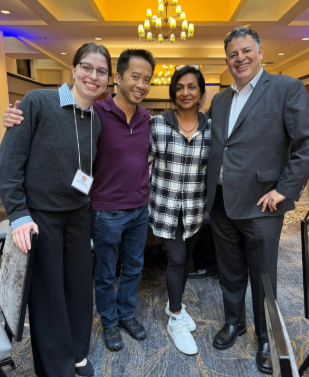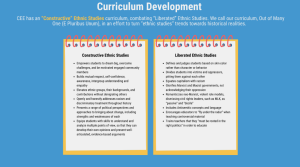David Bernstein’s Push for Constructive Ethnic Studies

David Bernstein (right) led discussions on politicized curricula and antisemitism at the Empowered Ed 2024 Leadership Summit in Sacramento, CA, alongside fellow CLARITy members Soraya Deen (second to right) and Mars Cheung (second to left). AHA Development Associate Susanna McIntyre (left) was also in attendance.
April 3, 2025
Ethnic Studies curricula—rooted in radical critical theory and mandated in several U.S. states—have fostered ideological bias, stifled critical thought, and fueled antisemitism in K-12 education. It has sparked growing resistance from parents, educators, and lawmakers.
David Bernstein, founder of the North American Values Institute (formerly the Jewish Institute for Liberal Values), has led efforts to counter these radical ideologies in education. Collaborating with the Alliance for Constructive Ethnic Studies (ACES), he developed “Out of Many, One,” an alternative curriculum that champions pluralism, mutual respect, and unity within diversity.
In this interview with David, we delve into the controversies surrounding ethnic studies, the dangers of ideological indoctrination in K-12 classrooms, and the significance of Bernstein’s work in redefining the future of education.
AHA Foundation: We need to begin by asking you to tell our supporters about Liberated Ethnic Studies (LES), more commonly known as Ethnic Studies, as many are unfamiliar with this class and its current curriculum. Where are Ethnic Studies mandated?
David Bernstein: Taken literally, ethnic studies would seem to be the study of the various ethnic groups that make up our diverse nation. Liberated Ethnic Studies, however, is deeply rooted in critical theory; it reinforces education as activism with a focus on political power according to group identity, and it explicitly calls for the dismantling of Western institutions.
California was the first state to mandate the teaching of ethnic studies in public schools. While California does not call its Ethnic Studies Model Curriculum “Liberated” or “Critical” ethnic studies, the curriculum is very much based—and it says so in the guiding principles—on fostering a “critical consciousness” among the student population. That is, the California curriculum is designed to help students to recognize and resist the systems of oppression that are supposedly in every nook and cranny of American life.
The guiding principles say, for example, that ethnic studies courses will “Challenge racist, bigoted, discriminatory, and imperialist/colonial beliefs and practices on multiple levels. Connect ourselves to past and contemporary social movements that struggle for social justice and an equitable and democratic society, and conceptualize, imagine, and build new possibilities for a post-racist, post-systemic-racism society that promotes collective narratives of transformative resistance, critical hope, and radical healing.” The California curriculum is a slightly sanitized version of liberated ethnic studies.
There’s also mandated ethnic studies in Minnesota and Oregon. It is infused in the curricula of several other states, such as Illinois, Massachusetts, and Washington.
It is controversial for several reasons: First, it’s an extremist pedagogy calling for the dismantling of supposed systems of oppression, such as the U.S. government and other “settler-colonial” states. Second, in brazenly promoting a specific worldview, it stifles critical thinking. Students are told there’s only one legitimate point of view. Third, in its obsession with Israel, which may or may not be specifically cited in the curriculum, it fosters a hostile environment for Jewish students and teachers.
“Under this framework, the only reason one group does better than another group is discrimination and marginalization. So because Jews are significantly above the mean in income and education, they must be holding other groups down.”
AHA Foundation: How have Ethnic Studies fueled antisemitism over the years? Does your research lead you to think that this is intentional, or is it happening as an unintended consequence of a broader ideological worldview?
David Bernstein: Ethnic Studies fuels antisemitism in two ways: first, it promotes the settler colonialism paradigm which sees Israel and Israelis as colonizers and ultimately leads to dehumanization of Jews in Israel. It’s no accident that many liberated ethnic studies activists celebrated the massacre of October 7th. Second, by advancing the oppressor-oppressed binary in the U.S., it inevitably treats American Jews as oppressors.
Under this framework, the only reason one group does better than another group is discrimination and marginalization. So because Jews are significantly above the mean in income and education, they must be holding other groups down.
AHA Foundation: Some argue that education has always had political elements—what makes today’s politicization different from past decades?
David Bernstein: I think it’s true that it’s impossible to make education entirely apolitical, but we can make it liberal by exposing students to a range of viewpoints on contentious political, social, and economic issues, and give them the critical thinking tools to develop well-informed opinions.
I support Israel, but if I were a social studies teacher, I would want my students to hear a range of perspectives on Israel and the conflict, not just my own. It’s unthinkable that a teacher would want students to get only one side of an issue. What’s different now is that many teachers and school systems believe they have “the answer” and see it as their solemn duty to indoctrinate students and turn them into social justice activists.
“Much of it is not explicitly anti-capitalist—some practitioners want to give minorities a boost in our market economy. Whereas ethnic studies in its dominant form really wants to dismantle America and other Western societies and is thus a more extreme expression of the same ideology.”
AHA Foundation: The new presidential administration has made the dismantling of DEI into one of their early priorities. Is there a connection between Ethnic Studies and DEI? If so, what is it?
David Bernstein: Ethnic studies and DEI both emerge out of critical theory, which holds that knowledge is constructed by powerful actors in society who embed their power in discourses and use it to hold others down. Now not all DEI is equally bad. I’ve talked to people in corporate America whose DEI programs are essentially mentorship initiatives for minority employees. I’ve also seen genuinely liberal forms of DEI.
Typically, however, DEI promotes critical theory and a specific outlook on disparity among groups–that is, the powerful people are holding down the powerless people. DEI seeks adherence to the theory. Thus, “diversity” does not refer to the range of human differences or viewpoints but dividing people into distinct identity groups and assigning them status as either oppressors or the oppressed.
I think it’s worth pointing out that not everyone who supports DEI is trying to rip the country into pieces. They may think they’re just helping traditionally marginalized people get a leg up. Much of it is not explicitly anti-capitalist—some practitioners want to give minorities a boost in our market economy. Whereas ethnic studies in its dominant form really wants to dismantle America and other Western societies and is thus a more extreme expression of the same ideology.
AHA Foundation: How have parents in these states reacted to the current Ethnic Studies curriculum? Was there any pushback, and how did it play out?
David Bernstein: Parents have started to self-organize all over the country through WhatsApp groups, etc. They were stunned at the educational materials their children were bringing home, particularly during the Covid-19 school closures. There’s definitely a major backlash in California to ethnic studies.
In the Jewish community, people and organizations have reacted in two disparate ways: one group opposes only the most explicitly antisemitic teachings and says little if anything about fighting the larger ideology, and the second fights the whole ideological enterprise, knowing it will generate antisemitism and anti-American sentiment. I very much identify with the latter camp.
I don’t imagine that the ethnic studies people understood they’d be fighting tooth and nail in school districts across California and other states as well. We’ve kept them in check in many places around the country. They’ve got, however, a big head start and we need to play catch up. That requires building a whole new advocacy ecosystem that understands how education systems work and can use levers of power to restore a semblance of normalcy to education.
“We want students to be exposed to a range of ideas and to debate them. I’d be perfectly happy if my son read Ibraham X. Kendi as long as he read the critique of him by, say, John McWhorter. Tragically, our school systems seem to want to either extol Kendi or ban him.”
AHA Foundation: Did state legislators take action over the years, and how were those actions received? What has NAVI done to raise awareness about the current curriculum?
David Bernstein: California led the way by mandating ethnic studies and several other states, such as Oregon, Minnesota, and Massachusetts, followed suit. We initially thought that we were vulnerable in all blue states, but some states chose not to go down that path. Ideological educators then started pushing the curricula district by district, so the fight has fragmented.
In red states, like Texas and Florida, the governors and legislators took action in the opposite direction. Both states sought to inoculate themselves against these radical trends and ban “divisive concepts” (such as Critical Race Theory), which is its own variety of illiberalism. We want students to be exposed to a range of ideas and to debate them. I’d be perfectly happy if my son read Ibraham X. Kendi as long as he read the critique of him by, say, John McWhorter. Tragically, our school systems seem to want to either extol Kendi or ban him.
With the possibility of the Department of Education being shut down or, at the very least, defunded, more and more education policy and funds are going to the states. It’s critical that we keep our eye on the ball and intervene effectively at the state level.
AHA Foundation: How did the idea for the new Constructive Ethnic Studies curriculum originate? Who has contributed to its development? What is its primary objective? How was the title “Out of Many, One” chosen?
David Bernstein: My friend Elina Kaplan founded the Alliance for Constructive Ethnic Studies (ACES) in the early stages of the ethnic studies debate in California. From the very beginning, she tried to offer an alternative to the ideological ethnic studies on offer. While it would be nice if ethnic studies simply went away, and we returned to teaching history and civics, with an appropriate focus on the role of different minority communities in U.S. history, we felt it was important to give educational institutions an alternative curriculum that wasn’t crazy and simply told the story of America’s pluralistic community.
In partnership with ACES, my organization, the North American Values Institute (formerly the Jewish Institute for Liberal Values), founded the Coalition for Empowered Education. We put together a multiethnic coalition to advance a “constructive” form of ethnic studies and came out with a curriculum in February of 2025 called “Out of Many, One,” a translation of e pluribus unum, which is such a powerful testament to America’s commitment to diversity and unity.
Our curriculum is trying to help students see themselves and their communities not as adversaries to the American story, but as integral to it. Diversity only works if disparate groups see themselves as part of something larger. Identity politics has lost the plot. This curriculum and efforts like it are trying to restore a healthy American pluralism that both respects particular cultural expressions and unites us in a sense of mission around the American creed.
AHA Foundation: What are the next steps? How can parents and others care about and support these efforts?
David Bernstein: Our goal over time is to build a movement of parents who are not just united in opposing radical ideology but in supporting core American and Western values. Parents are absolutely key to such efforts. They must not look the other way when bad stuff is happening and actively promote good stuff.
This starts first by educating parents about the radical ideology in their kids’ schools. They need to become amateur philosophers in the sense that they have to recognize and name various forms of radical ideology showing up in their kids’ schools. One day, it’s critical race theory and the next, it’s “culturally responsive education” or “critical literacy.” It’s all the same thing in different packaging. Then we need to train parents to counter the ideology in an effective way with their kids’ schools and to run for school board. This is not going to happen overnight. It’s a generational project. It took more than 50 years for the ideologues to conduct their “Long March through the Institutions.” It might take twenty for us to reverse course.



